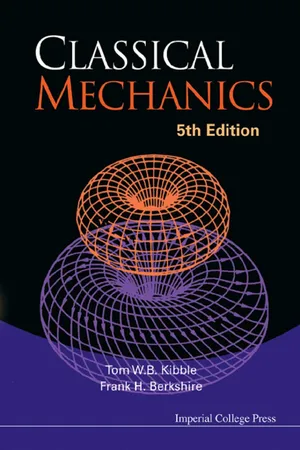
- 500 pages
- English
- ePUB (mobile friendly)
- Available on iOS & Android
Classical Mechanics
About this book
This is the fifth edition of a well-established textbook. It is intended to provide a thorough coverage of the fundamental principles and techniques of classical mechanics, an old subject that is at the base of all of physics, but in which there has also in recent years been rapid development. The book is aimed at undergraduate students of physics and applied mathematics. It emphasizes the basic principles, and aims to progress rapidly to the point of being able to handle physically and mathematically interesting problems, without getting bogged down in excessive formalism. Lagrangian methods are introduced at a relatively early stage, to get students to appreciate their use in simple contexts. Later chapters use Lagrangian and Hamiltonian methods extensively, but in a way that aims to be accessible to undergraduates, while including modern developments at the appropriate level of detail. The subject has been developed considerably recently while retaining a truly central role for all students of physics and applied mathematics.
This edition retains all the main features of the fourth edition, including the two chapters on geometry of dynamical systems and on order and chaos, and the new appendices on conics and on dynamical systems near a critical point. The material has been somewhat expanded, in particular to contrast continuous and discrete behaviours. A further appendix has been added on routes to chaos (period-doubling) and related discrete maps. The new edition has also been revised to give more emphasis to specific examples worked out in detail.
Classical Mechanics is written for undergraduate students of physics or applied mathematics. It assumes some basic prior knowledge of the fundamental concepts and reasonable familiarity with elementary differential and integral calculus.
Contents:
- Linear Motion
- Energy and Angular Momentum
- Central Conservative Forces
- Rotating Frames
- Potential Theory
- The Two-Body Problem
- Many-Body Systems
- Rigid Bodies
- Lagrangian Mechanics
- Small Oscillations and Normal Modes
- Hamiltonian Mechanics
- Dynamical Systems and Their Geometry
- Order and Chaos in Hamiltonian Systems
- Appendices:
- Vectors
- Conics
- Phase Plane Analysis Near Critical Points
- Discrete Dynamical Systems — Maps
Readership: Undergraduates in physics and applied mathematics.
Classical Mechanics;Dynamical Systems;Order and Chaos;Lagrangian Methods;Hamiltonian Methods0 Key Features:
- Further development of the chapters on dynamical systems and their geometry, and on order and chaos, introduced in the fourth edition.
- Examples with solutions in the text, supplementing the wide range of problems with answers.
- Appendices on vectors, on conic sections, on dynamical systems near a critical point and, new in this edition, on routes to chaos and related discrete maps.
- Emphasis on basic principles of wide applicability.
- End-of-chapter summaries.
- A comprehensive index and list of symbols.
Frequently asked questions
- Essential is ideal for learners and professionals who enjoy exploring a wide range of subjects. Access the Essential Library with 800,000+ trusted titles and best-sellers across business, personal growth, and the humanities. Includes unlimited reading time and Standard Read Aloud voice.
- Complete: Perfect for advanced learners and researchers needing full, unrestricted access. Unlock 1.4M+ books across hundreds of subjects, including academic and specialized titles. The Complete Plan also includes advanced features like Premium Read Aloud and Research Assistant.
Please note we cannot support devices running on iOS 13 and Android 7 or earlier. Learn more about using the app.
Information
Chapter 1
Introduction
1.1Space and Time
The relativity principle
Inertial frames
Table of contents
- Cover
- Halftitle
- Title
- Copyright
- Dedication
- Preface
- Contents
- Useful Constants and Units
- List of Symbols
- 1. Introduction
- 2. Linear Motion
- 3. Energy and Angular Momentum
- 4. Central Conservative Forces
- 5. Rotating Frames
- 6. Potential Theory
- 7. The Two-Body Problem
- 8. Many-Body Systems
- 9. Rigid Bodies
- 10. Lagrangian Mechanics
- 11. Small Oscillations and Normal Modes
- 12. Hamiltonian Mechanics
- 13. Dynamical Systems and Their Geometry
- 14. Order and Chaos in Hamiltonian Systems
- Appendix A. Vectors
- Appendix B. Conics
- Appendix C. Phase Plane Analysis near Critical Points
- Appendix D. Discrete Dynamical Systems — Maps
- Answers to Problems
- Bibliography
- Index